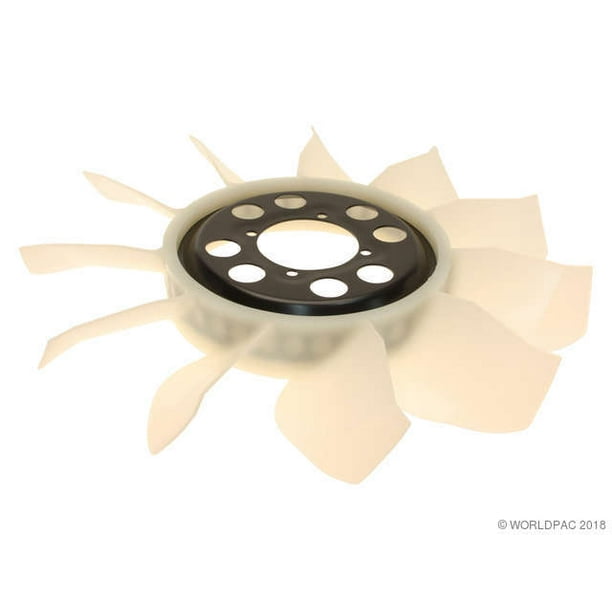About Fan Blades
Table of ContentsThe Facts About Fan Blades UncoveredGetting My Fan Blades To WorkWhat Does Fan Blades Do?
Non-thermal clutches run entirely based on the shaft speed of the water pump. At low and idling speeds, the clutch enables the fan blade to turn at practically a 1:1 ratio. At high speeds, the silicone fluid within in the clutch will lose its capability to transfer the energy from the shaft to the fan clutch body (and therefore, the fan) and the fan is then allowed to practically free-wheel, eliminating its load from the engine.However, non-thermal clutches are a lower-cost choice than thermal-style clutches. The thermal fan clutch runs in action to underhood temperatures. As hot air blows throughout the radiator, it heats up a thermal spring mounted at the front of the clutch. As the spring is heated, it turns and enables valve ports to open within the clutch.
This engages the clutch and drives the fan. Once the engine is cooled down, the thermal spring turns back and closes the valve ports, disengaging the fan. The speed at which a thermal fan clutch spins a fan depends mostly on the precise fan you select. On the Top Racing website, for instance, you'll find 3 different kinds of thermal fan clutches from Hayden alone: This style turns the fan at 60-70 percent of the water pump shaft speed when engaged, and 20-30 percent when disengaged.
This fan design turns the fan at 70-90 percent of the shaft speed when engaged for increased cooling. When disengaged, it turns the fan at 25-35 percent. It's utilized with deeper-pitch fans (2Â 1/2 of pitch), and works well with higher operating rpm. Severe duty thermal fans turn the fan at 80-90 percent of the shaft speed when engaged and 20-30 percent when disengaged.
This design of fan clutch runs like a thermal clutch, however the ECM/PCM signal manages the level of engagement of the EV clutch. This engagement procedure is eventually managed through the ECM/PCM by the following input variables: Coolant Temperature, Consumption Manifold Temperature Level, Transmission Oil Temperature Level, A/C Pressure and Engine Oil Temperature Level.
Like all parts, fan clutches will wear and need replaced. fan blades. According to Hayden, here are some signs your fan clutch may require changed: Fan spins excessively when engine is stopped (3 or more times when hot engine is shut off). Poor A/C efficiency at idle or low vehicle speeds.
Little Known Facts About Fan Blades.

Fan speed does not increase up until engine is excessively hot. Fan blade tip moves more than 1/4-inch front to back. Fan turns roughly or does not turn at all. Extreme fan noise at all speeds due to unsuccessful bearing. Vibration that increases with engine speed. Dripping fluid or oily develop around the bearing or thermal spring.
289, 302, W/ FAN CLUTCH MANAGER 302, W/ FAN CLUTCH 250, W/ FAN CLUTCH W/ FAN CLUTCH, REPLACEMENT 289, FACTORY A/C AND FAN CLUTCH 289, DELUXE DEALERSHIP A/C 200, FACTORY A/C, POWER FAN, W/O EMISSIONS FAIRLANE, TORINO, 200, A/C, POWER FAN, W/ EMISSIONS: This item can expose you to chemicals including lead and DEHP, which are known you could try here to the State of California to cause cancer and abnormality or other reproductive damage.

Almost unusual on modern-day cars with electrical engine cooling fans, people often still refer to the accessory drive belts as "fan belts." This term harkens to the day when cars and trucks and trucks used drive belts to drive the cooling fan or water pump. The engine cooling fan, made from plastic or metal, isn't hard-connected to the fan wheel or water pump, but instead is soft-connected through the fan clutch.
A stopping working fan clutch could leave you stranded with costly repair expenses, so focus on these symptoms. Here, you can see where the fan and fan clutch are driven by the engine (fan blades). Morio/ Wikimedia Commons There are 3 kinds of fan clutch, depending upon the automobile's design. A little quantity of resistance always keeps the fan spinning, however it's basically free-wheeling till the fan clutch engages.

4 Easy Facts About Fan Blades Shown
A centrifugal valve opens to enable the flow of heavy silicone fluid, locking the fan blades to the pulley. At idle and low engine speeds, this fan clutch is totally engaged, gradually disengaging as engine speed boosts. Depending upon the application, it might freewheel above 2,500 to 3,000 rpm. An functions special info comparable to thermal and torque-limiting types but isn't regulated straight by temperature level or speed.
If the fan clutch is spoiling or has failed, there are a number of methods you may see. Focusing on your automobile is the initial step in a precise medical diagnosis, reliable repair work, and dependable automobile. at low speed or when stopped is the most-common fan clutch failure sign.
At a stop, though, since the fan clutch doesn't engage and air isn't forced through the radiator, the engine can't dissipate excess heat. in winter is another typical problem however brought on by the opposite fan clutch failure. If the fan clutch seizes, it remains engaged all the time, cooling off the engine excessive.
This can cause bearing damage, radiator damage if the blades bend too far, or even shatter a plastic fan. after engine shut-down might indicate a weak clutch. Silicone fluid leaking from the fan clutch would cause this problem. When the engine is off, there are a few things you can do to check the click to read more fan clutch:. fan blades.